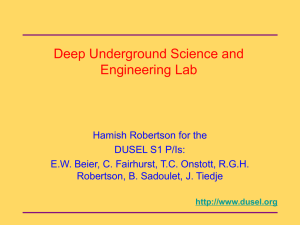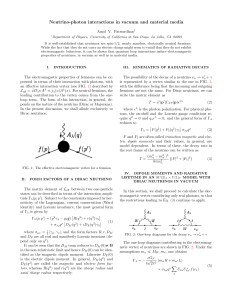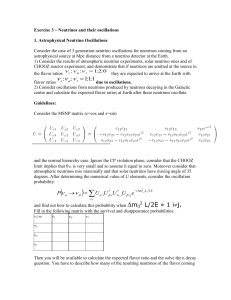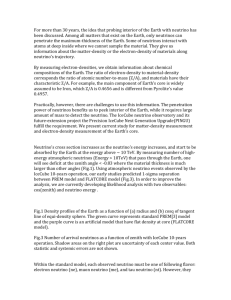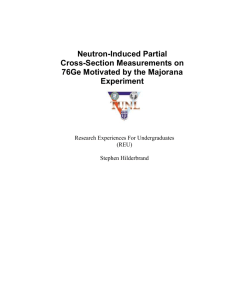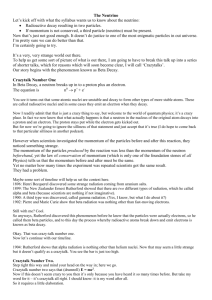Page 18: - proj-muon
advertisement
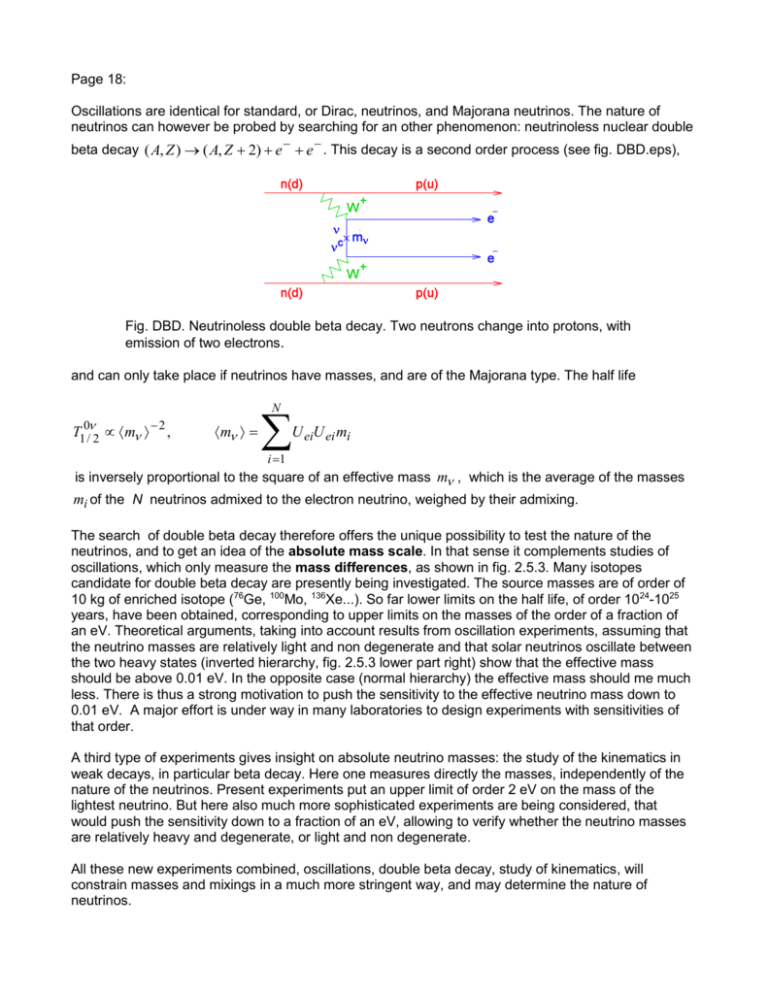
Page 18: Oscillations are identical for standard, or Dirac, neutrinos, and Majorana neutrinos. The nature of neutrinos can however be probed by searching for an other phenomenon: neutrinoless nuclear double beta decay ( A, Z ) ( A, Z 2) e e . This decay is a second order process (see fig. DBD.eps), Fig. DBD. Neutrinoless double beta decay. Two neutrons change into protons, with emission of two electrons. and can only take place if neutrinos have masses, and are of the Majorana type. The half life N T10/2 m 2 , m U eiU ei mi i 1 is inversely proportional to the square of an effective mass m , which is the average of the masses mi of the N neutrinos admixed to the electron neutrino, weighed by their admixing. The search of double beta decay therefore offers the unique possibility to test the nature of the neutrinos, and to get an idea of the absolute mass scale. In that sense it complements studies of oscillations, which only measure the mass differences, as shown in fig. 2.5.3. Many isotopes candidate for double beta decay are presently being investigated. The source masses are of order of 10 kg of enriched isotope (76Ge, 100Mo, 136Xe...). So far lower limits on the half life, of order 1024-1025 years, have been obtained, corresponding to upper limits on the masses of the order of a fraction of an eV. Theoretical arguments, taking into account results from oscillation experiments, assuming that the neutrino masses are relatively light and non degenerate and that solar neutrinos oscillate between the two heavy states (inverted hierarchy, fig. 2.5.3 lower part right) show that the effective mass should be above 0.01 eV. In the opposite case (normal hierarchy) the effective mass should me much less. There is thus a strong motivation to push the sensitivity to the effective neutrino mass down to 0.01 eV. A major effort is under way in many laboratories to design experiments with sensitivities of that order. A third type of experiments gives insight on absolute neutrino masses: the study of the kinematics in weak decays, in particular beta decay. Here one measures directly the masses, independently of the nature of the neutrinos. Present experiments put an upper limit of order 2 eV on the mass of the lightest neutrino. But here also much more sophisticated experiments are being considered, that would push the sensitivity down to a fraction of an eV, allowing to verify whether the neutrino masses are relatively heavy and degenerate, or light and non degenerate. All these new experiments combined, oscillations, double beta decay, study of kinematics, will constrain masses and mixings in a much more stringent way, and may determine the nature of neutrinos. Dans les prospectives: As shown previously, there is a strong motivation to push the sensitivity in searches for neutrinoless double beta decay down to 0.01 eV. This means probing half lives of order 1028 years. This requires source masses much larger than the 10 kg or so in present experiments. Source masses of order 100 kg in a first step, to 10 t in a final stage, are being considered. Russia seems to have the facilities to produce enriched isotopes in these quantities. To take full advantage of these larger set-ups however it will be necessary to reduce drastically the background from natural and cosmogenic activities, which limits the sensitivity. This can be achieved by better event signature, and/or a selection of materials with a higher level of radiopurity for the construction of the detectors. The EXO collaboration, with a swiss participation, has started an R&D program to develop an experimental set-up with the aforementioned sensitivity. The source will consist in xenon enriched in 136 Xe, in gas or liquid form. The source will at the same time be the detector medium. The experiment will evolve in 3 steps. First a 50 kg will be built and tested. An effort will be made to reduce natural and cosmogenic activities using state of the art existing techniques. Then a larger device with a source mass of 1000 kg will be constructed, already allowing a substantial improvement of the sensitivity. It is foreseen from this version on to use a drastically new approach to reduce further the background. This will be done by measuring not only the two electrons, as is usually done, but also by identifying in coincidence the 136Ba ion produced in the decay. This is possible in principle by exciting the ion with a laser, after detection of the electrons, and measuring the deexcitation photons. This feature, if it can be made to work, will lead to an essentially backgroundfree experiment. The evolution of the sensitivity, as it is foreseen at the moment, is depicted in fig. timetable. Fig. timetable. Evolution of the sensitivity to the effective neutrino mass in EXO, assuming that the background can be completely suppressed. The final sensitivity should be comparable to that aimed for in the GENIUS experiment, which uses a different approach, relying solely on new methods to reduce background generating natural and cosmogenic activities.

